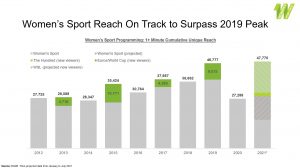Latest figures from the Women’s Sport Trust, with broadcast analysis from Futures Sport & Entertainment, show that more people in the UK are watching women’s sport and they’re spending more time than ever before watching Barclays Women’s Super League (BWSL) matches.
A record 22.6 million people watched 3+ minutes of women’s sport* between January and May 2024 – up on the previous best of 22.0 million during the same period in 2023 – with a 10% growth in free-to-air viewing hours (53.8 million v 48.7 million in January-May 2023). Football, rugby union and cricket had the largest audience.
The BWSL saw a record-high of 40 minutes viewed per game, on average, in the 2023/24 season, up 11% year-on-year. Sky Showcase’s audience watched 43 minutes per game on average (up 26% year-on-year), and BBC One audiences averaged 47 minutes (up 18% year-on-year), which was the highest of any channel.
The importance of channel scheduling was evident in the Barclays Women’s Super League, with BBC One averaging 698,000 per match versus BBC Two at 396,000. As a consequence, the difference between having four matches on BBC One in 2023-24 versus seven the season before, contributed to an overall drop in 3+ minute reach from 16.1m to 15.1m. Live viewing hours also declined from 36.3 million to 36.1 million.
The report pointed to the complex nature of consumption habits across different properties. Of the 15.1 million people who watched the Barclays Women’s Super League:
- 6.5 million watched both BWSL and the Premier League
- 5 million watched the Lionesses and the Premier League
- 4.5m only watched the BWSL
- 5.5 million people only watched the Lionesses
BWSL teams are also seeing different levels of exposure and results:
- Chelsea, who had 18 of their 22 league matches broadcast in the 2023/24 season, had the highest broadcast reach of any BWSL team, with 17.5 million viewers, followed by Manchester City (15.8m) and Arsenal (15.4m).
- Five teams in the league had cumulative reach of 3.1 million or lower across this season, with Leicester City having four matches broadcast on Sky and BBC’s linear channels, which was less than a quarter of the games shown of the league champions, Chelsea. The top placed league team, Chelsea, had 9.2 times the broadcast reach of Bristol City, the BWSL’s bottom team – this compares to a difference in live cumulative reach of 7.6 times between the Premier League club with the highest reach (Manchester United) and the club with the lowest reach (Burnley).
- Manchester United had the highest average linear broadcast audience of any team, with 348k per game, with four BBC games out of the 10 broadcast overall. Chelsea, Arsenal and Manchester City appeared on Sky the most during the league across the course of the season (12, 10 and 7 games respectively).
Overall women’s sport* saw huge growth across the first five months of 2024:
- The Women’s Six Nations, shown on BBC, was the most viewed on record with 8.1m tuning in for 3 minutes or more (33% more than in 2023). 2.4 million saw only the Women’s Six Nations event in 2024, in comparison to 1.6 million who watched the women’s only event in 2023
- 19% of rugby league fans watched both the men’s and women’s Challenge Cup final in 2024 – up on 7% in 2021
The Women’s Sport Trust report highlighted digital best practice globally, showcasing how the WNBA has delivered significant digital growth across a range of platforms, including achieving 60m views on TikTok in May 2024 according to Tubular Labs data (beating the previous best of 26 million in April 2024), and how Barcelona women’s football team has seen a near fourfold increase in TikTok views by focusing on culturally relevant content.
The BWSL also experienced digital growth on channels such as TikTok, with the league TikTok account seeing views increase from 92.9 million in 2022-23 to 147 million in 2023-24.
Tammy Parlour, Women’s Sport Trust Chief Executive, said: “Growth is never equal across all metrics, but rising audiences and deeper engagement across both linear and digital platforms are positive takeaways.”
“Fans have more information and choice than ever before and women’s sport has to compete with wider entertainment properties for visibility and cultural relevance.
“While the success of a country, team or player plays a huge role in keeping fans engaged, the industry needs to continue to drive interest through greater prominence, cross promotion and adapting marketing and activation strategies to appeal to the unique nature of the different fan behaviours within women’s sport.”



